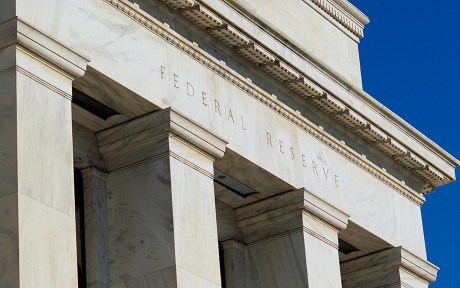
In a 2024 post, we showed that interdealer trading in benchmark U.S. Treasury notes and bonds concentrates on the last trading day of the month, likely due to passive investment funds’ turn-of-month portfolio rebalancing. In this post, we extend our trading activity analysis to the full range of Treasury securities and market segments. We find that trading is even more concentrated on the last trading day of the month for other types of Treasury securities and in the dealer-to-customer segment of the market, with trading volume in off-the-run Treasuries twice as high as on other days, on average.
Turning from Interdealer Data to TRACE Data
In our earlier post, we showed that interdealer trading volume in benchmark (or on-the-run) Treasury notes and bonds is roughly 46 percent higher on the last trading day of the month. Our data for that work came from the interdealer broker market, in which dealers and principal trading firms transact. Our data source did not include trading by customers and it did not include trading in off-the-run securities.
In this post, we use data from the Financial Industry Regulatory Authority’s (FINRA) Trade Reporting and Compliance Engine (TRACE). TRACE captures data on all trades of dealers and certain depository institutions, including their trades with customers. Moreover, TRACE covers trades across the full range of Treasury securities, including bills, Treasury Inflation-Protected Securities (TIPS), floating rate notes (FRNs), and both off-the-run and on-the-run notes and bonds.
Our source of Treasury TRACE data is FINRA’s Treasury Daily Aggregate Statistics, with daily information available from February 13, 2023. The data are aggregated across dealers and across broad categories of securities for all Treasuries except on-the-run notes, bonds, and TIPS, for which activity is reported by security. Activity is further split into “ATS (Alternative Trading System) and Interdealer” (which we refer to as “Interdealer”) and “Dealer-to-Customer” segments.
Controlling for Day-of-Week Effects
As in our earlier post, we control for day-of-week effects in our analysis. This matters because the last trading day of the month is about three times more likely to fall on a Friday than on other weekdays and because trading volume tends to be about 11 percent lower on Fridays, on average. By comparison, volume is 9 percent lower than average on Mondays, whereas volume is higher than average on Tuesdays, Wednesdays, and Thursdays (by 3 percent, 9 percent, and 6 percent, respectively).
End-of-Month Patterns Are Stronger than Prior Work Suggests
Overall Treasury security trading volume is about 58 percent higher on the last trading day of the month than on other days, on average (see chart below). This increase is appreciably larger than the 46 percent increase found in our earlier blog post, which examined interdealer broker trading of on-the-run notes and bonds. These findings imply that the end-of-month pattern is even stronger in the dealer-to-customer segment and/or for off-the-run securities.
Trading Volume Is Much Higher on the Last Day of the Month
Percent difference
Notes: The chart shows the average percent deviation of overall Treasury security trading volume on each day of the month as compared to the average for the same day of the week for the two weeks preceding and following that day. Days of the month are plotted relative to the last day of the month, with 0 being the last trading day and 1 being the first trading day. The sample period is February 13, 2023, to June 13, 2025.
End-of-Month Patterns Vary by Market Segment
The end-of-month increase in trading volume in the dealer-to-customer segment is 73 percent, as shown in the chart below, much greater than the 46 percent increase observed in the interdealer segment. The larger increase in the dealer-to-customer segment does not seem surprising given our conjecture that the end-of-month pattern is driven by customer activity. Dealers likely offset some but not all of their trading with customers in the interdealer segment.
End-of-Month Volume Increase Is Greater in the Dealer-to-Customer Segment
Percent difference
Notes: The chart shows the average percent deviation of Treasury security trading volume by market segment on the last day of the month as compared to the average for the same day of the week for the two weeks preceding and following that day. The sample period is February 13, 2023, to June 13, 2025.
End-of-Month Patterns Vary by Security Type
The end-of-month increase in trading volume also varies across securities, as shown in the next chart, averaging 220 percent for FRNs, 167 percent for TIPS, 63 percent for notes and bonds, and 30 percent for bills. The larger end-of-month increases for FRNs and TIPS may reflect these securities’ more common end-of-month issuance and maturity dates as well as investors’ greater inclination to concentrate their trading in these less active securities. For context, daily trading volume over our sample period averages about $3 billion for FRNs, $18 billion for TIPS, $174 billion for bills, and $701 billion for notes and bonds.
End-of-Month Volume Increase Is Greater in FRNs and TIPS
Percent difference
Notes: The chart shows the average percent deviation of Treasury security trading volume by security type on the last day of the month as compared to the average for the same day of the week for the two weeks preceding and following that day. The sample period is February 13, 2023, to June 13, 2025. FRNs = floating rate notes. TIPS = Treasury Inflation-Protected Securities.
The table below shows that the patterns discussed above generally hold across security types within a market segment and across market segments within a security type. The one exception is that we find a larger end-of-month increase for FRNs in the interdealer segment than the dealer-to-customer segment. This is explained by the fact that the FRNs’ interdealer segment has low volume generally, with some large outliers for the end-of-month increases. So when looking at the median end-of-month increase, which is less sensitive to outliers, the interdealer segment for FRNs has a smaller increase than the dealer-to-customer segment.
End-of-Month Volume Increase Is Consistently Greater in Dealer-to-Customer Segment and for FRNs and TIPS
| Market Segment | |||
| Security Type | Dealer-to-Customer | Interdealer | All |
| Bills | 36.9 | 18.3 | 30.0 |
| Notes and bonds | 81.2 | 49.3 | 62.7 |
| TIPS | 198.4 | 109.5 | 167.4 |
| FRNs | 240.5 | 251.0 | 219.6 |
| All | 72.9 | 45.8 | 58.4 |
Notes: The table shows the average percent deviation of Treasury security trading volume by market segment and security type on the last day of the month as compared to the average for the same day of the week for the two weeks preceding and following that day. The sample period is February 13, 2023, to June 13, 2025. FRNs = floating rate notes. TIPS = Treasury Inflation-Protected Securities.
End-of-Month Patterns Vary by On-the-Run/Off-the-Run Status
Our last chart shows that the end-of-month increase in trading volume is 108 percent for off-the-run securities versus 52 percent for on-the-run securities. The increases are larger for TIPS than for notes and bonds, as shown above, with the on-the-run/off-the-run differentials similar across security types. The larger end-of-month increases for off-the-runs may reflect customers’ greater ownership and hence trading of these securities. Trading in on-the-run securities, in contrast, is concentrated among dealers and principal trading firms.
End-of-Month Volume Increase Is Greater in Off-the-Run Securities
Percent difference
Notes: The chart shows the average percent deviation of Treasury security trading volume by security type and on-the-run/off-the-run status on the last day of the month as compared to the average for the same day of the week for the two weeks preceding and following that day. The sample period is February 13, 2023, to June 13, 2025.
The table below shows that the patterns discussed above hold within a particular market segment, security type, and on-the-run/off-the-run status. That is, the end-of-month volume increase is more pronounced in the dealer-to-customer segment, for TIPS, and for off-the-run securities.
End-of-Month Volume Increase Is Consistently Greater in Dealer-to-Customer Segment, for TIPS, and for Off-the-Run Securities
| Market Segment | ||||
| Security Type | Status | Interdealer | Dealer-to-Customer | All |
| Notes and bonds | On-the-run | 44.3 | 61.1 | 50.2 |
| Off-the-run | 79.8 | 118.4 | 104.3 | |
| TIPS | On-the-run | 103.5 | 187.9 | 151.6 |
| Off-the-run | 131.3 | 220.9 | 196.1 | |
| Both | On-the-run | 45.0 | 64.6 | 52.0 |
| Off-the-run | 80.8 | 122.9 | 107.7 |
Notes: The table shows the average percent deviation of Treasury security trading volume by market segment, security type, and on-the-run/off-the-run status on the last day of the month as compared to the average for the same day of the week for the two weeks preceding and following that day. The sample period is February 13, 2023, to June 13, 2025. TIPS = Treasury Inflation-Protected Securities.
Summing Up
Trading activity is more highly concentrated on the last trading day of the month than our earlier analysis suggests. In particular, the end-of-month increase in trading volume is greater in the dealer-to-customer segment, greater for off-the-run securities, and greater for FRNs and TIPS than for notes and bonds. These findings are important for market participants managing trade execution strategies and for policymakers monitoring market functioning and liquidity provision. Future work could explore whether the increased end-of-month trading in these other parts of the market is associated with improved liquidity, as we found for benchmark notes and bonds in our past work.

Michael J. Fleming is head of Capital Markets in the Federal Reserve Bank of New York’s Research and Statistics Group.
Jonathan Palash-Mizner, a former undergraduate intern at the Bank, is a student at Yale University.

Or Shachar is a financial research advisor in the Federal Reserve Bank of New York’s Research and Statistics Group.
How to cite this post:
Michael J. Fleming, Jonathan Palash-Mizner, and Or Shachar, “End‑of‑Month Activity across the Treasury Market,” Federal Reserve Bank of New York Liberty Street Economics, October 9, 2025, https://doi.org/10.59576/lse.20251009
BibTeX: View |
Disclaimer
The views expressed in this post are those of the author(s) and do not necessarily reflect the position of the Federal Reserve Bank of New York or the Federal Reserve System. Any errors or omissions are the responsibility of the author(s).













 RSS Feed
RSS Feed Follow Liberty Street Economics
Follow Liberty Street Economics